Ever wonder why big visions so often stall out in the day-to-day? Even the most ambitious companies can lose momentum when strategies stay trapped in slide decks while execution lives in a maze of spreadsheets and siloed teams. The result: wasted resources, misaligned priorities, and slow progress on what matters most.
Corporate strategic planning bridges this gap. It’s the blueprint that turns vision into action by aligning every department, project, and person around shared goals. In this guide, you’ll discover how to build a strategy that actually gets done, connect long-term ambitions to daily work, and drive results with confidence.
Try monday work managementKey takeaways
- Corporate strategic planning transforms scattered efforts into focused action by defining your 3-5 year direction and connecting big goals to daily work.
- Success requires making tough trade-offs between competing priorities like growth versus profitability or innovation versus efficiency.
- The best strategic plans work supportively across 4 levels: corporate, business, functional, and operational.
- Corporate strategic planning has 5 distinct steps: define your vision, analyze your position, develop initiatives, allocate resources, and monitor progress consistently.
- AI-powered platforms like monday work management bridge the strategy-execution gap by connecting corporate objectives to daily workflows.
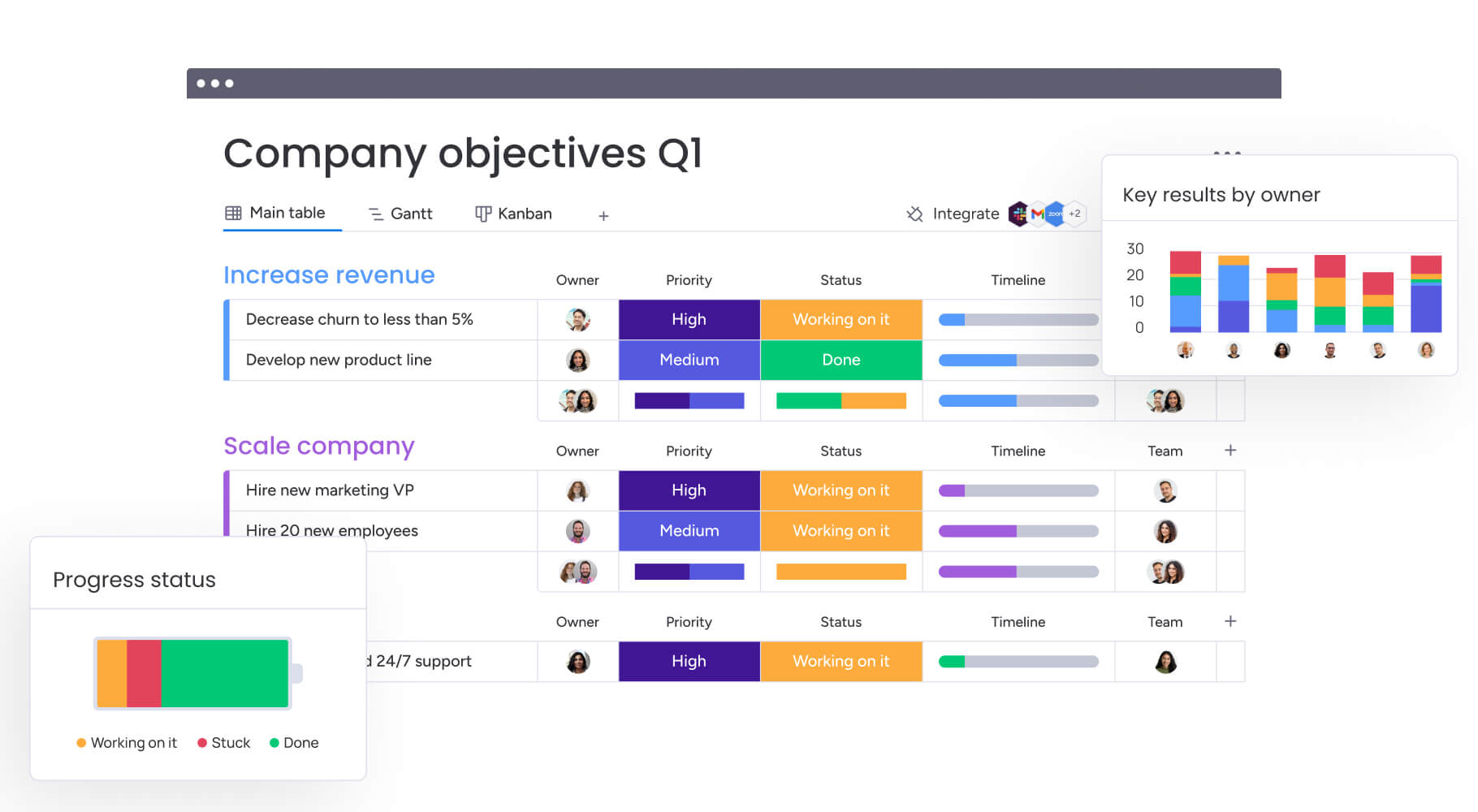
What is corporate strategic planning?
Corporate strategic planning is the process of setting your organization’s long-term direction and creating a strategic plan to get there. This means defining where you want to be in 3-5 years and making decisions about how to allocate resources, enter new markets, and position yourself against competitors.
Think of it as your organization’s master plan. While daily operations keep the business running, strategic planning determines which direction you’re running toward.
The process involves analyzing your current position, understanding market opportunities, and making tough choices about where to focus. You’ll need to decide which markets to enter or exit, how much to invest in different areas, and what capabilities to build for the future — important aspects of portfolio planning.
Corporate strategic planning vs business strategy planning
Although corporate strategic planning and business strategy planning sound similar, they serve different purposes. Understanding the distinction helps you apply the right approach at the right level. Here’s how they differ in practice:
| Aspect | Corporate strategic planning | Business strategy planning |
|---|---|---|
| Scope | Entire organization | Single business unit |
| Timeline | 3-5+ years | 1-3 years |
| Key decisions | Portfolio choices, capital allocation | Competitive positioning, target customers |
| Decision makers | CEO, board of directors | Business unit leaders |
| Example questions | Which businesses should we be in? How do we allocate resources across our portfolio? | How do we win in our specific market? What makes us different from competitors? |
Both levels need to work together. Corporate strategy sets the boundaries and resources, while business strategy determines how to compete within those constraints.
Why strategic planning matters for corporate success
Strategic planning is a catalyst for meaningful progress across your entire organization. When strategy moves off the page and into your workflows, the impact is felt by every team and every project. Here are some of the benefits of implementing meaningful corporate strategic planning:
- Sharper resource allocation: Focus investments on the initiatives that matter most, so teams aren’t spread thin across competing priorities.
- Faster decision-making: With clear frameworks and priorities in place, teams can act decisively instead of getting bogged down in endless debates.
- Smarter insights with AI-powered analytics: AI tools help leadership teams cut through data noise, forecast market shifts, and test scenarios before committing resources — turning planning from guesswork into evidence-based decision-making.
- Stronger organizational alignment: When everyone knows the direction and their role, goals become more achievable and execution picks up speed. In fact, employees who understand how success is measured are twice as likely to feel motivated, yet research shows only about 5% of employees actually understand their company’s strategy.
- Measurable business results: Companies with aligned strategic plans consistently report faster growth, higher employee engagement, and a stronger competitive edge compared to those that operate without a clear direction.
By embedding strategic planning into your organization’s daily rhythm, you transform lofty goals into real outcomes. It also enables stronger customer experiences by aligning every touchpoint to strategic priorities, and ensures ESG commitments and risk considerations are embedded in planning — not treated as afterthoughts.
Try monday work management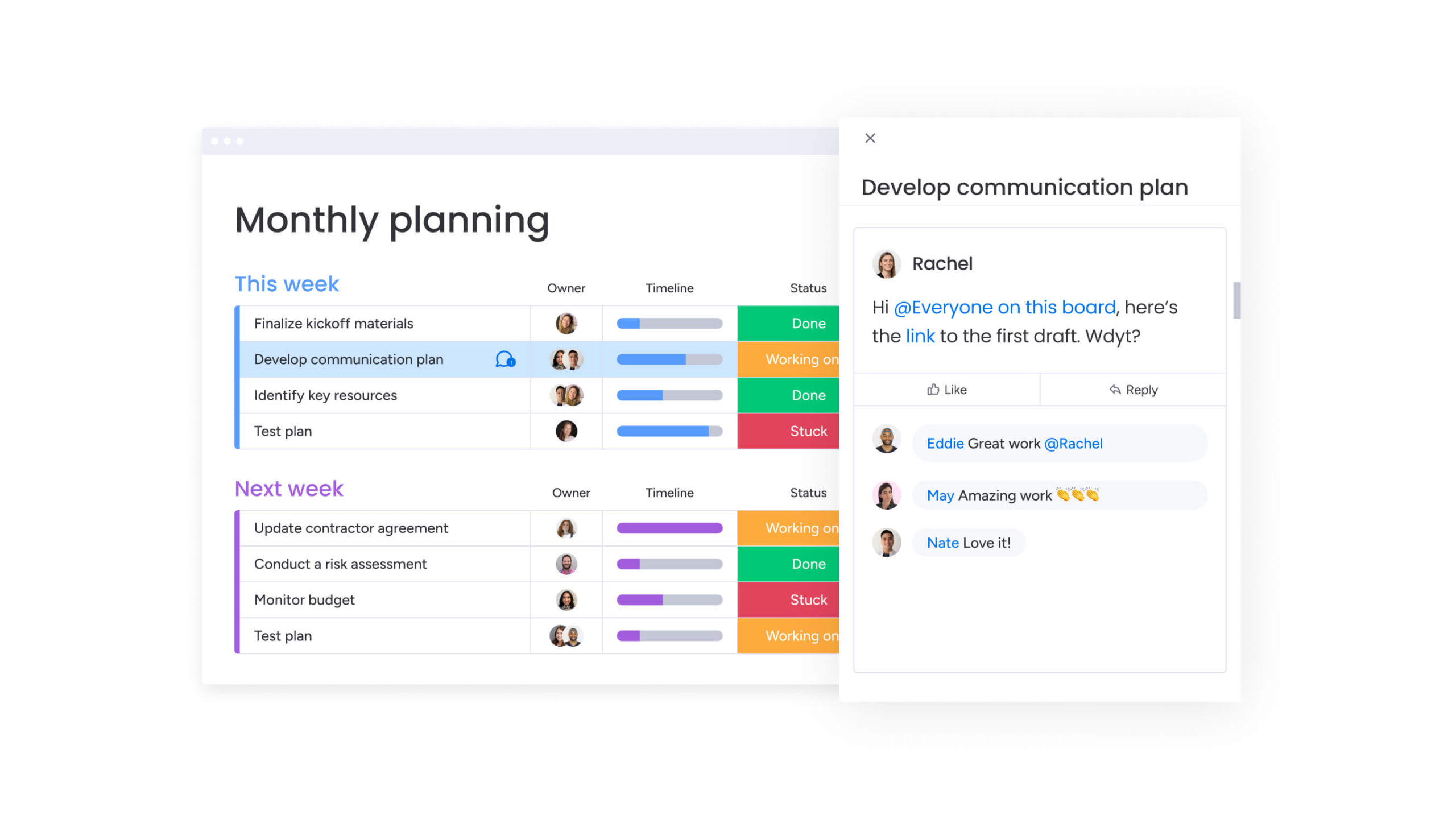
Key components of corporate strategic planning
Every strategic plan needs certain building blocks to succeed, and the following components work together to transform goals into action.
Vision and mission development
Your vision statement describes where you want your organization to be in the future. Your mission explains why your organization exists and what value it provides today.
These aren’t just feel-good statements for your website. They guide every strategic decision you make. When you’re deciding between two opportunities, your vision and mission help you choose the path that aligns with your long-term direction and overall organizational strategy.
Strategic objective development
Strategic objectives turn your vision into measurable goals, which is a central element of goal management. These are specific targets that show whether you’re making progress toward your vision.
Good business objectives follow frameworks like OKRs (Objectives and Key Results) that connect high-level goals to specific outcomes. For example, if your vision includes market leadership, you might develop a brand awareness strategy, with objectives targeting specific market share percentages or customer satisfaction scores.
Resource allocation and prioritization
You have limited resources in the form of money, people, and time. Strategic planning forces you to decide where to invest these resources for maximum impact, which often means saying no to good opportunities to focus on great ones.
Plus, AI algorithms can optimize budget allocation and workforce planning by modeling multiple what-if scenarios, so leaders understand trade-offs before making high-stakes calls.
For example, Unilever uses AI simulations to predict the impact of raw material price fluctuations, which helps the company allocate resources more effectively toward its sustainability goals.
Strategic trade-offs and decision making
Every strategic choice involves trade-offs. You can’t be everything to everyone. Strategic planning helps you make these difficult decisions consciously rather than by default.
Common trade-offs include:
- Growth vs. profitability: Investing in expansion or maximizing current returns
- Innovation vs. efficiency: Developing new capabilities or perfecting existing ones
- Market breadth vs. depth: Serving many segments adequately or dominating a few
Other common trade-offs include prioritizing ESG goals vs short-term returns, or balancing investment in cybersecurity with rapid digital transformation.
With AI-powered software, you can surface hidden patterns in market and operational data for clearer visibility into which trade-offs will have the greatest long-term impact. Amazon illustrates this balance by using AI to optimize inventory and logistics. This allows the company to pursue rapid growth while maintaining efficiency and profitability — a classic example of managing corporate-level trade-offs with data-driven tools.
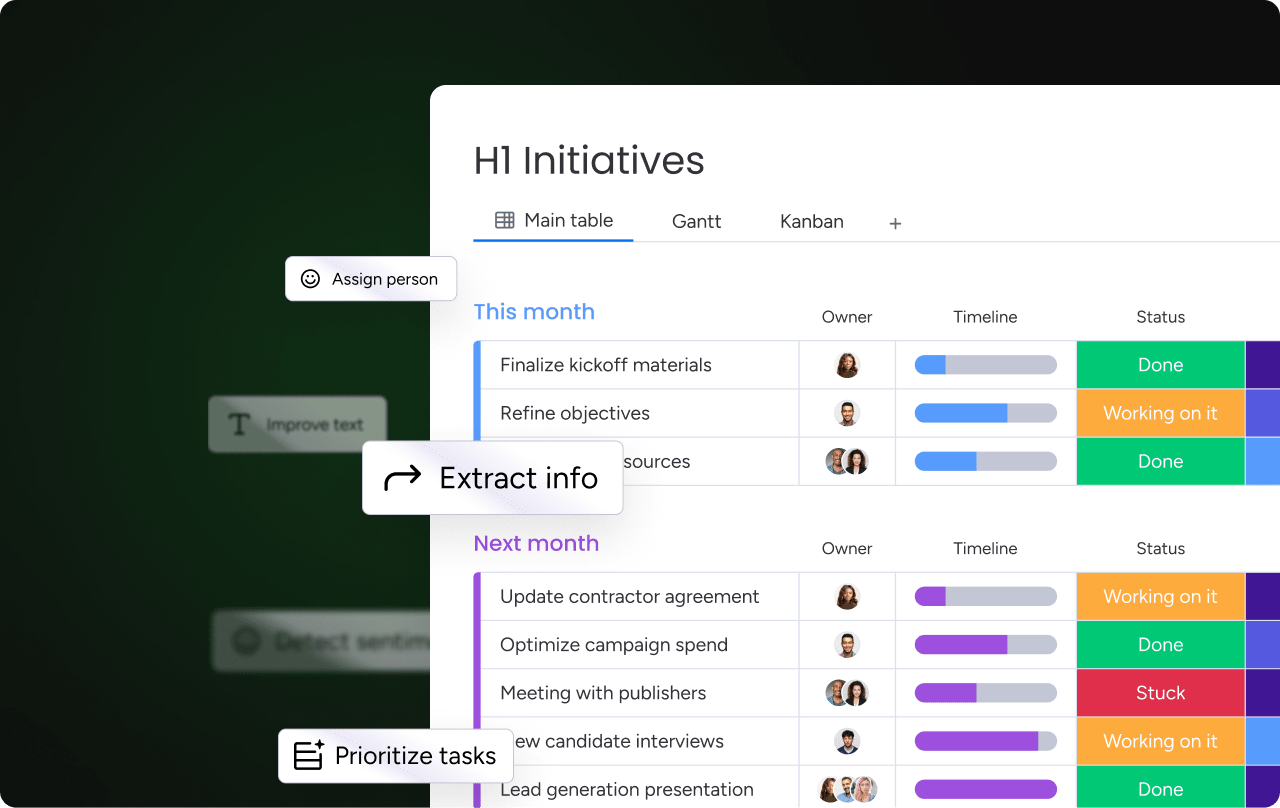
4 types of corporate strategic planning strategies
Organizations can pursue different strategic directions based on their situation and goals. Each approach requires different capabilities and accepts different levels of risk.
Growth strategies
Growth strategies expand your organization’s reach through new markets, products, or acquisitions. This approach works when you see clear opportunities and have resources to pursue them.
Growth strategies often depend on innovation and R&D investments, whether through developing new products internally or acquiring startups to accelerate capability building. The key is ensuring growth strengthens rather than dilutes your competitive position.
Stability strategies
Stability strategies maintain your current position while refining your operations strategy. You’re not trying to grow dramatically — you’re perfecting what you already do well.
This approach makes sense in mature markets or after periods of rapid change because it lets you consolidate gains and build operational excellence without the risks of expansion.
Retrenchment strategies
Reduce scope to focus on core strengths. This might mean exiting unprofitable markets, selling non-core assets, or restructuring operations. Don’t think of retrenchment as failure; it’s strategic focus that frees resources for areas where you can truly excel.
Combination strategies
Most large organizations use combination strategies, applying different approaches to different parts of their business. You might grow in emerging markets while retrenching from declining ones.
To support this complexity, monday work management helps provide visibility across diverse initiatives, aiding strategy portfolio management so leaders can balance different approaches within one coherent plan.
Try monday work management4 levels of strategic planning in organizations
Strategic planning happens at multiple levels, each with its own focus and timeline. These levels must align to create coherent organizational direction.
Corporate-level strategy
Corporate-level strategy is the highest level, typically owned by the CEO and board. It determines the overall scope and direction of the organization.
Key decisions include which businesses to enter or exit, how to allocate capital, and whether to pursue mergers or acquisitions. These choices shape everything else the organization does, reinforcing the importance of organizational project management.
Business-level strategy
Business-level strategy focuses on competing within specific markets. Each business unit develops its own strategy for winning customers and beating competitors.
This level translates corporate direction into market-specific plans. It determines positioning, pricing, and value propositions for particular customer segments, which all tie into effective marketing strategies.
Functional-level strategy
Functional-level strategy aligns departments like marketing, operations, and HR with business goals. Each function develops plans to support competitive advantage.
For example, if business strategy emphasizes premium quality, operations might focus on quality control while HR recruits specialized talent.
Operational-level strategy
Operational-level strategy turns plans into daily work. This includes project management, workflow design, and performance tracking that execute strategic initiatives.
This is where strategic execution meets reality, and monday work management excels here by connecting key goals to everyday workflows and projects.
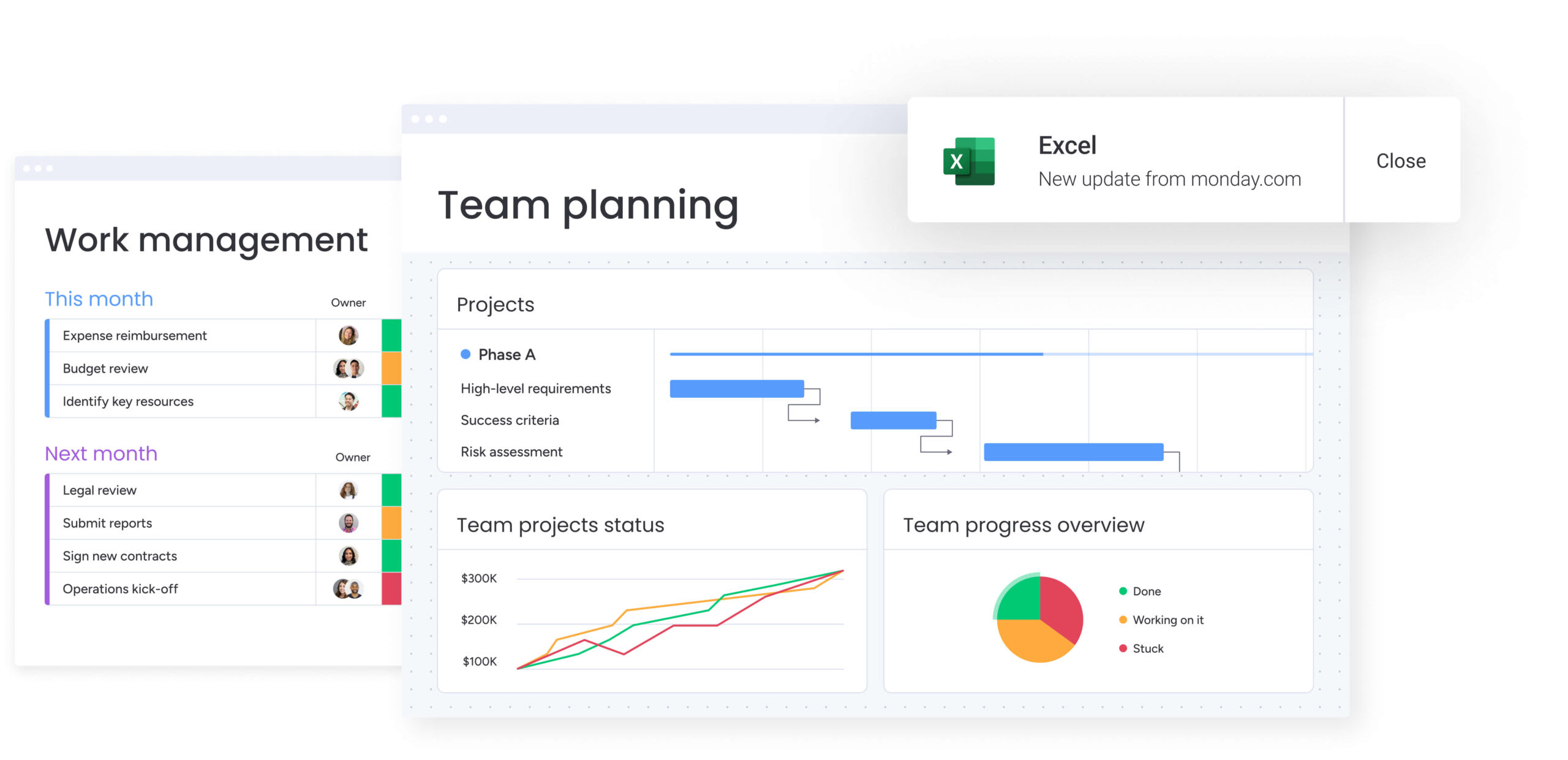
5 steps to create a company strategic plan
Creating a strategic plan doesn’t have to be overwhelming. Follow these steps to build a plan that actually drives results, or explore a business strategy template for extra guidance.
Step 1: Define your strategic vision and objectives
Start by articulating where you want your organization to be. Your vision should inspire while remaining achievable and then translate that vision into specific, measurable objectives.
Engage key stakeholders early, because their buy-in and input make the difference between a plan that sits on a shelf and one that drives real change, which is critical when you consider that 45% of senior leaders believe change is managed “very well,” while only 23% of individual contributors agree.
Step 2: Assess your current position and market
Take an honest look at where you stand today. What are your strengths and weaknesses? What opportunities and threats exist in your market, aspects often clarified through a risk assessment?
Use frameworks like SWOT analysis to structure your thinking. But go beyond the framework to dig into customer feedback, competitive intelligence, and market trends to build a complete picture.
For example, during the COVID-19 pandemic, Pfizer relied on AI-driven forecasting during the vaccine rollout to model demand scenarios and optimize global distribution, aligning corporate strategy with health impact objectives.
Pro tip: AI-driven market intelligence platforms provide real-time competitor insights and trend forecasting, helping organizations avoid blind spots during strategic analysis.
Step 3: Develop your strategic initiatives
Identify the strategic initiatives needed to achieve your objectives. These are the big moves that will transform your organization’s position.
Prioritize ruthlessly. You can’t do everything at once, so zero in on initiatives with the highest impact and clearest path to success. With monday work management, you can visualize dependencies and resource management requirements across initiatives.
Step 4: Allocate resources and set timelines
Determine what resources each initiative needs and when, including budget, people, and technology. Be realistic about timelines — think ambitious but achievable.
Build in flexibility, because markets change. Your plan needs room to adapt without losing focus on core objectives.
Step 5: Implement monitoring and evaluation systems
Set up systems to track progress and adjust course, potentially through scenario planning. Define key performance indicators for each objective and schedule regular reviews.
Monitoring isn’t about micromanagement; it’s about catching issues early and celebrating wins along the way. Use dashboards and automated reporting to keep everyone aligned without creating reporting burden.
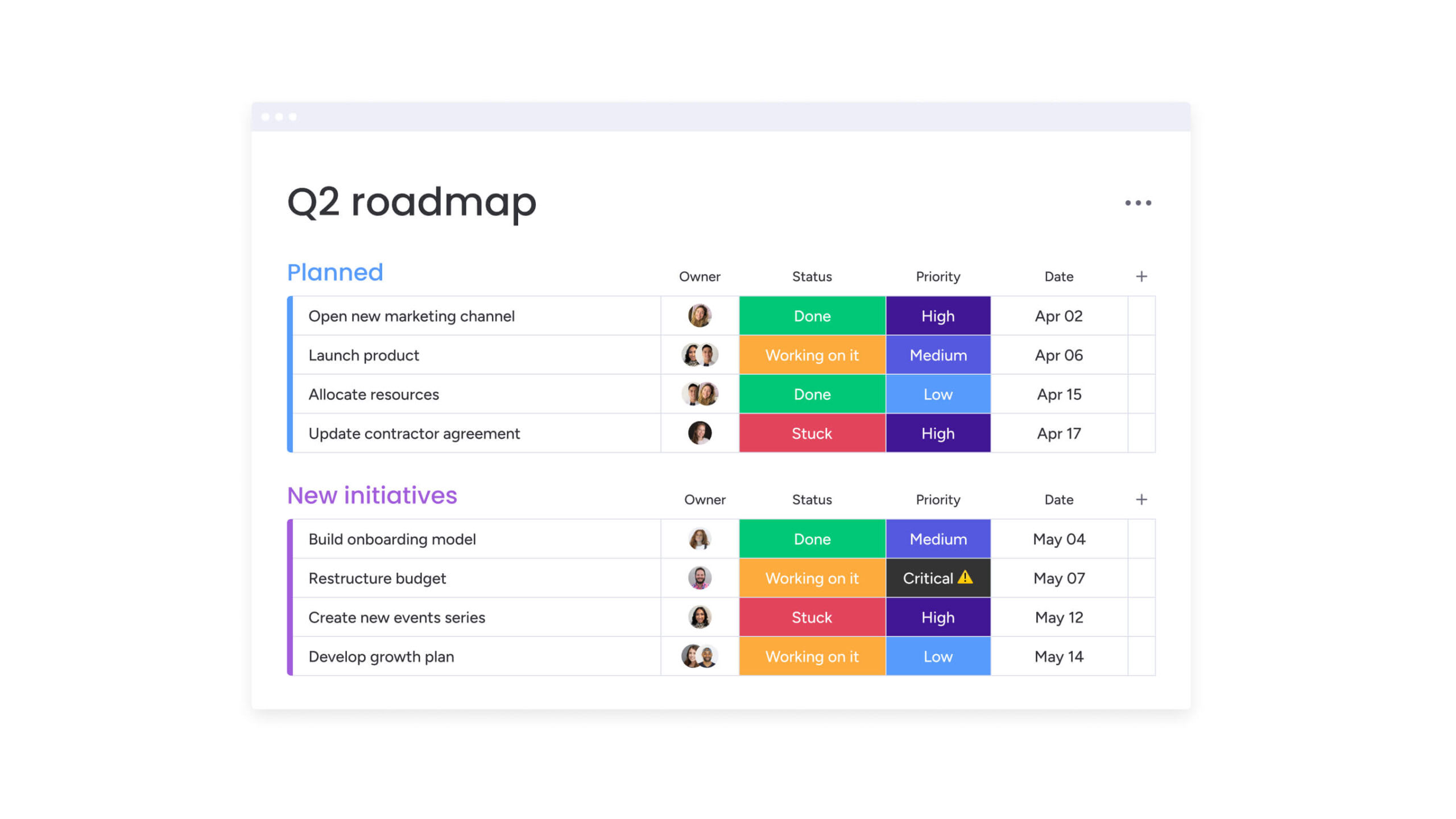
Build your corporate strategic plan with monday work management
Strategic planning only works when it connects to execution, and that’s where many organizations struggle: translating big ideas into daily work. Unlike generic planning tools, monday work management integrates strategy with execution — turning high-level objectives into visible, trackable progress across your entire organization.
The platform offers several capabilities that make strategic planning more effective:
- Goal-setting frameworks: Build and cascade top-level objectives into actionable team goals. monday work management’s customizable OKR and KPI templates ensure every department and individual can align their daily tasks with company-wide ambitions, making progress visible and measurable at every level.
- Resource management: Get a real-time overview of team capacity, project workloads, and budget allocation. Use visual dashboards and dynamic workload charts to balance resources efficiently, anticipate bottlenecks, and pivot quickly as priorities shift—no more guessing where your people or dollars are going.
- Progress tracking: Monitor advancement toward strategic goals with interactive dashboards, automated status updates, and milestone tracking. monday work management seamlessly connects high-level objectives to the granular details, enabling leaders and teams to celebrate wins and address obstacles before they impact results.
- Collaborative workspaces: Centralize communication, documentation, and project plans in shared boards. monday work management breaks down silos, empowering cross-functional teams to coordinate seamlessly, share updates, and keep everyone focused on shared strategic priorities — all in one platform.
- AI-powered insights: Leverage integrated AI tools to analyze performance data, forecast business scenarios, recommend process improvements, and proactively surface risks. Leaders get actionable, real-time analytics to make smarter strategic decisions and continuously refine their approach.te
Teams can start with strategic planning templates and customize them to fit their needs. As strategies evolve, the platform adapts, maintaining alignment even as priorities shift.
The result? Strategic plans that actually drive action rather than gathering dust. Organizations using monday work management report faster execution, stronger accountability, and more successful strategic initiatives.
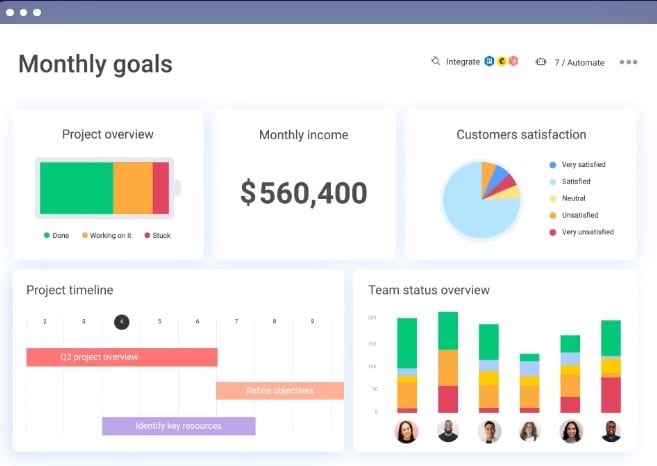
The future of corporate strategic planning is AI-powered
Strategic planning is no longer a static, annual exercise — it’s a continuous process that needs to adapt as markets shift, competitors evolve, and customer expectations change. AI is becoming the game-changer here, giving leaders tools to forecast trends, optimize resources, and adjust strategies in real time.
But AI only creates impact when it’s connected to the daily work of your teams. That’s where monday work management comes in. By linking corporate objectives to department goals and everyday workflows, the platform makes sure your strategy doesn’t just sit in a slide deck — it drives measurable results.
Try monday work managementFrequently asked questions
What is strategic planning in corporate?
Strategic planning in corporate settings is the process where organizations define their long-term direction and create actionable plans to achieve their goals. It involves analyzing market opportunities, allocating resources, and making decisions that position the company for sustained success over a 3-5 year period.
What are the 5 Cs of strategic planning?
The 5 Cs of strategic planning are company (internal analysis of strengths and capabilities), collaborators (partners and stakeholders), customers (target markets and needs), competition (competitive landscape analysis), and context (external environment including economic and regulatory factors). These elements provide a comprehensive framework for strategic analysis.
What are the 4 types of corporate strategy?
The 4 types of corporate strategy are growth (expanding market presence), stability (maintaining position while optimizing performance), retrenchment (reducing scope to focus on core strengths), and combination (blending different approaches across business units or time periods).
How often should companies review their corporate strategic plan?
Companies should review their corporate strategic plan quarterly for progress updates and annually for comprehensive evaluation. Most organizations conduct formal strategic planning sessions every 1-2 years while maintaining ongoing monitoring to adapt to changing conditions.
Who should be involved in corporate strategic planning?
Corporate strategic planning should involve senior executives, key department heads, and selected high-potential employees. The CEO typically leads the process, but successful planning requires diverse perspectives from across the organization to ensure realistic implementation and broad buy-in.
